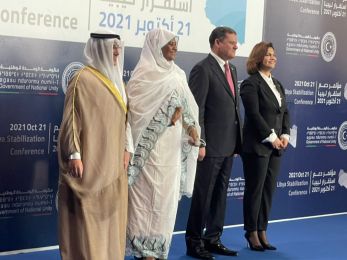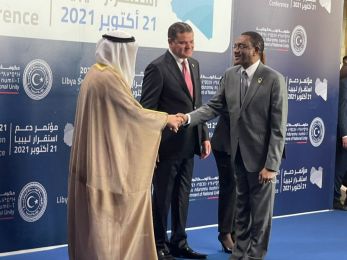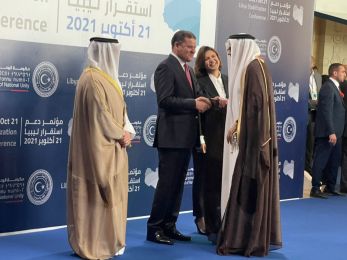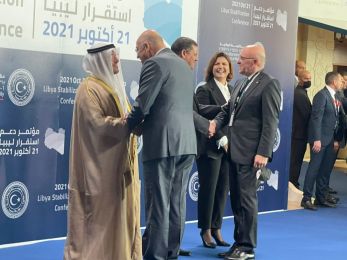PANAPRESS
Panafrican News Agency
Mauritania on track to beating drinking water shortages
Nouakchott, Mauritania (PANA) - Following the joint efforts by development partners, including the African Development Bank (AfDB), which invested US$45.7 million between 2003 and 2014 in water supply and sanitation projects, Mauritania is working to provide access to drinking water for its 4.3-million population, which regularly suffers severe shortages.
Key figures for this project are -
US$45.7 million: the total amount invested by the African Development Bank in the Mauritanian water and sanitation sector.
180,000: the number of additional people, living in 450 villages in the areas of M'bout, Monguel and Barkéol, who now have access to drinking water.
Achievable goal for 2020: 100% access to drinking water for all Mauritanians
For over a decade, the country has been able to meet only about half its estimated daily drinking water requirement of 100,000 m3, with a production level of around 55,000 m3 per day, from the only available aquifer, in Trarza, in the south west of the country.
This leaves only 68% of the population with access to potable water (at an average consumption of less than 50 litres per person per day), mostly in urban areas. In rural areas, there are recurrent acute shortages, leading to migration of people to the cities.
In the face of this critical situation, the former Mauritanian Minister for Water and Sanitation, Mohamed Abdallahi Ould Oudaa, announced government measures to urgently deal with the problem, promising during a plenary session of Parliament on 31 May 2016 that: "Eighty percent of the Mauritanian population will have access to drinking water by 2018 and 100% will have access by 2020."
After this announcement, sanitation and water supply projects gained renewed pace in both the capital, Nouakchott, and in various regions. Some projects are under construction, such as Maghtaa Lehjar and Sangrava and, especially, the "Aftout Essahli" Nouakchott Drinking Water Supply Project, which received US$32.5 million in funding over three phases (2003, 2008 and 2010) from the African Development Bank.
Further afield, the restoration and strengthening of the Nouadhibou, Gouraye and Sélibabi projects are ongoing via the National Integrated Rural Water Sector Project (PNISER), for which the Bank committed funding packages, in 2013 and 2014, worth US$13.2 million.
Seventeen of the 22 supply boreholes, initially planned, have been built and 9 of 22 new solar-powered drinking water supply (SDW) systems have been completed, leaving 11 in the reception phase and 2 under construction. Work has also been completed on the restoration of 10 old SDW systems. This has meant that 180,000 people living in 450 villages in the areas of M’bout, Monguel and Barkéol have access to potable water.
There remains a further 947 water supply systems to be completed in Mauritania. And before this, three pumping stations with outputs of, respectively, 170,000 m³/day, 160,000 m³/day and 150,000 m³/day will be built, to include design, build, testing and staff training.
One of the last steps in the process, which also includes the renovation of systems for the transfer of water from pumping stations on the Senegal River to pre-treatment and treatment plants, is the refurbishment of the connection to the treatment plant located at point PK 17 of the Nouakchott city distribution network.
According to the AfDB water engineer, Jalel El Faleh, sustainable access to drinking water for the inhabitants of Nouakchott is gradually moving forward, in a limited fashion due to the lack of a proper distribution system.
Leaks in the old distribution system are another difficulty. These continue to be significant, leading to disruptions to supply in some low-lying areas of the city.
Rural areas of the country also suffer regular shortages due to declining rainfall and the restricted technical and financial capacity of the Mauritanian National Rural Water Supply Agency, responsible for supplying more than 800 rural centres of population.
"The goal of supplying 80% of the population with drinking water by the end of 2018 remains difficult to achieve," acknowledged Faleh, who believes that a major effort remains to be made.
"Even so,” he added, “the main performance indicators for the sector show that the goal of providing access to water for 100% of the population by 2020 is possible and the 2030 deadline is practicable if Mauritania, with the support of its technical and financial partners, manages to implement the necessary projects and programmes."
-0- PANA VAO 28Nov2018
Key figures for this project are -
US$45.7 million: the total amount invested by the African Development Bank in the Mauritanian water and sanitation sector.
180,000: the number of additional people, living in 450 villages in the areas of M'bout, Monguel and Barkéol, who now have access to drinking water.
Achievable goal for 2020: 100% access to drinking water for all Mauritanians
For over a decade, the country has been able to meet only about half its estimated daily drinking water requirement of 100,000 m3, with a production level of around 55,000 m3 per day, from the only available aquifer, in Trarza, in the south west of the country.
This leaves only 68% of the population with access to potable water (at an average consumption of less than 50 litres per person per day), mostly in urban areas. In rural areas, there are recurrent acute shortages, leading to migration of people to the cities.
In the face of this critical situation, the former Mauritanian Minister for Water and Sanitation, Mohamed Abdallahi Ould Oudaa, announced government measures to urgently deal with the problem, promising during a plenary session of Parliament on 31 May 2016 that: "Eighty percent of the Mauritanian population will have access to drinking water by 2018 and 100% will have access by 2020."
After this announcement, sanitation and water supply projects gained renewed pace in both the capital, Nouakchott, and in various regions. Some projects are under construction, such as Maghtaa Lehjar and Sangrava and, especially, the "Aftout Essahli" Nouakchott Drinking Water Supply Project, which received US$32.5 million in funding over three phases (2003, 2008 and 2010) from the African Development Bank.
Further afield, the restoration and strengthening of the Nouadhibou, Gouraye and Sélibabi projects are ongoing via the National Integrated Rural Water Sector Project (PNISER), for which the Bank committed funding packages, in 2013 and 2014, worth US$13.2 million.
Seventeen of the 22 supply boreholes, initially planned, have been built and 9 of 22 new solar-powered drinking water supply (SDW) systems have been completed, leaving 11 in the reception phase and 2 under construction. Work has also been completed on the restoration of 10 old SDW systems. This has meant that 180,000 people living in 450 villages in the areas of M’bout, Monguel and Barkéol have access to potable water.
There remains a further 947 water supply systems to be completed in Mauritania. And before this, three pumping stations with outputs of, respectively, 170,000 m³/day, 160,000 m³/day and 150,000 m³/day will be built, to include design, build, testing and staff training.
One of the last steps in the process, which also includes the renovation of systems for the transfer of water from pumping stations on the Senegal River to pre-treatment and treatment plants, is the refurbishment of the connection to the treatment plant located at point PK 17 of the Nouakchott city distribution network.
According to the AfDB water engineer, Jalel El Faleh, sustainable access to drinking water for the inhabitants of Nouakchott is gradually moving forward, in a limited fashion due to the lack of a proper distribution system.
Leaks in the old distribution system are another difficulty. These continue to be significant, leading to disruptions to supply in some low-lying areas of the city.
Rural areas of the country also suffer regular shortages due to declining rainfall and the restricted technical and financial capacity of the Mauritanian National Rural Water Supply Agency, responsible for supplying more than 800 rural centres of population.
"The goal of supplying 80% of the population with drinking water by the end of 2018 remains difficult to achieve," acknowledged Faleh, who believes that a major effort remains to be made.
"Even so,” he added, “the main performance indicators for the sector show that the goal of providing access to water for 100% of the population by 2020 is possible and the 2030 deadline is practicable if Mauritania, with the support of its technical and financial partners, manages to implement the necessary projects and programmes."
-0- PANA VAO 28Nov2018






